The Cathedral of Quito (Spanish: La Catedral de Quito, officially La Catedral) is the cathedral church in Quito, Ecuador. Located on the southern side of La Plaza Grande, it serves as the seat of the Roman Catholic Archdiocese of Quito. It is considered to be one of the oldest cathedrals in South America.
Atypical of Spanish city design, the cathedral has two entrances: one is part of the nave facing La Plaza Grande and the other is at the west facade facing Garcia Moreno street with an east-west orientation. It was completed io 1569
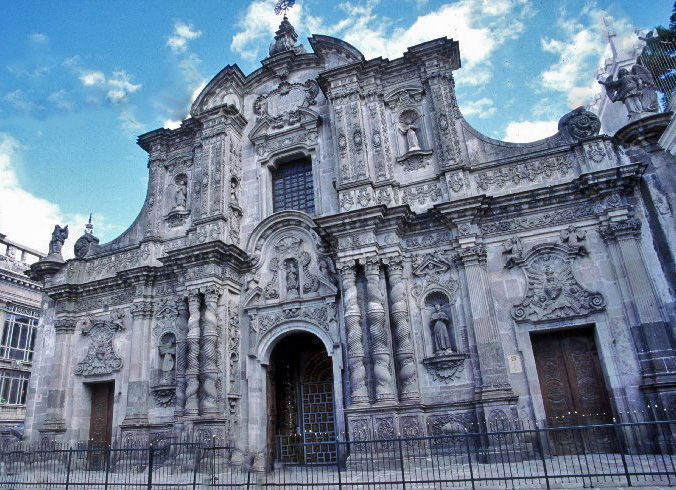

Construction began in 1605, The building was not completed until 1765.
It is estimated that there are seven (7) tons of gold used in the decoration of this church. That’s 14,000 lbs. or 168,000 troy oz. Gold is now around $1,600 per oz = $268,800,000 worth of gold. Would buy a bunch of food for hungry kids, wouldn’t it?
Locally this church is known as the Gold Church. Wonder why?
 |
 |
 |
San Francisco was the first church built in Quito. Construction began in 1535, just 1 month after the Spanish arrived. (It took more than 100 years to finish.) You’ll notice that Plaza San Francisco is distinctly sloped; for several hundred years, it was assumed that it followed the shape of the earth. However, a group of archaeologists have discovered that San Francisco was built over an Inca temple, which is the reason the actual church is much higher than other structures in Quito. As you walk up the stairs from the plaza to the church, you can’t help but notice how wide the stairs are. Supposedly the architects designed the stairs this way so that as you approach the church, you have to keep your eyes on your feet to watch where you’re going—in other words, you are forced to bow your head in respect. Like La Compañía, San Francisco is an important baroque church, but the latter is much larger and, for some reason, feels much more somber.
Plaza San Francisco and it’s church/Monastery: The Iglesia y Monasterio de San Francisco (Church and Monastery of St. Francis), colloquially known as El San Francisco, is a colonial styled church and monastery located in Quito. The founder of the church is Franciscan missionary Joedco Ricke. The construction of the Church and Convent of St. Francis began around 1535 and was finished in approximately 1680. The building was officially inaugurated in 1605. With the support of European Franciscans, the Belgian Friar Jodoco Ricke and Friar Pedro Gosseal, who came to the city two years after its founding, acquired land to the west side of the city’s main plaza. This plot was where the palace of the Inca ruler Atahualpa had once stood. In addition to being a market center for indigenous Ecuadorians, it was also location of the military seats of the chiefs of indigenous armies. All told, the place had enormous strategic and historical significance for the indigenous people the Franciscans wanted to evangelize.
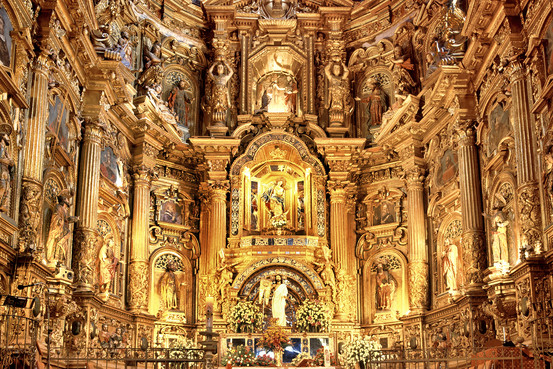
The ceilings have a beautiful Moorish design. In the entryway, as in LaCompañía,
I noticed images of the sun, which were used to lure indigenous people to the
Christian religion. Throughout the church are combinations of indigenous and
Catholic symbols. For example, the interior is decorated with angels in the shape of
the sun—and the faces of these angels have distinct Indian characteristics
This gold leaf side wall section was so massive that
I could not get it all in the photo
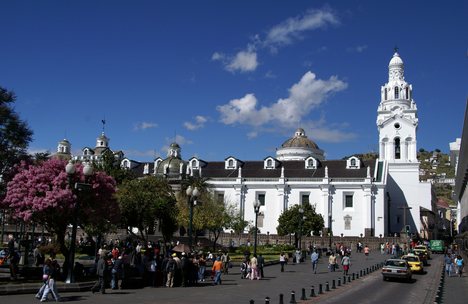
 |
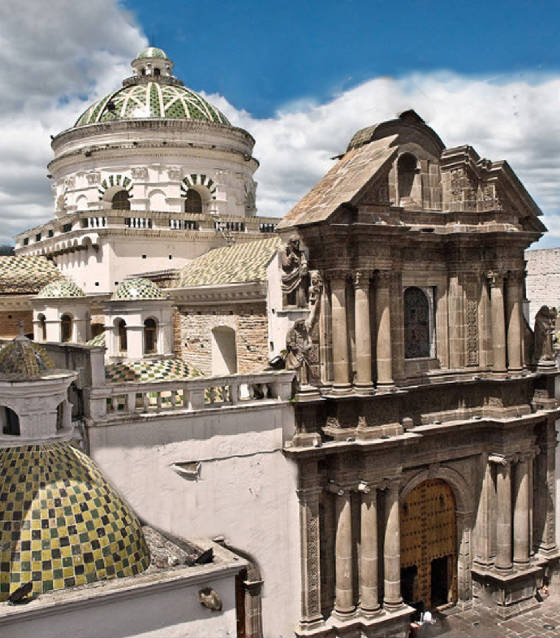
Construction on the awe-inspiring Metropolitan Cathedral started some time between 1550 and 1560, with various additions and renovations being made until it stood completed in 1806. A fine historical example of past architectural styles, the Cathedral of Quito stands proudly as an important religious symbol for the people of the city. Those who come to view this fine structure will be impressed by the number of styles that blend so well together in the architecture of the Metropolitan Cathedral. The arches feature late Gothic design, whilst the main altar is more Baroque in nature. Notably, the choir area is Neoclassic and the ceilings boast Moorish styling.
Basílica del Voto Nacional: Construction of the basilica started in 1887, The work slowly progressed for five years.To continue construction, donations were accepted from believers, who provided stones in exchange for engraving their names on them. In 1895, the state established a tax on salt to continue the building.
On July 10, 1892, the first stone was placed. Between 1892 and 1909, the Heart of Mary Cathedral was constructed. The basilica was blessed by Pope John Paul II on January 30, 1985, and it was consecrated and inaugurated on July 12, 1988.
The basilica remains technically “unfinished.”Local legend says that when the Basílica is completed, the end of the world will come. Maybe work will be complete on 12/21/2012???? Lets hope not.
The basilica is the most important work of Neogothic Ecuadorian architecture and is one of the most representative of the Americas. It is the largest neogothic basilica in the New World. The building is noted for its grotesques in the form of native Ecuadorian animals, such as armadillos, iguana, and Galapagos tortoises.
I’m not sure which grotesque this represents. Some kind of
big cat I guess.
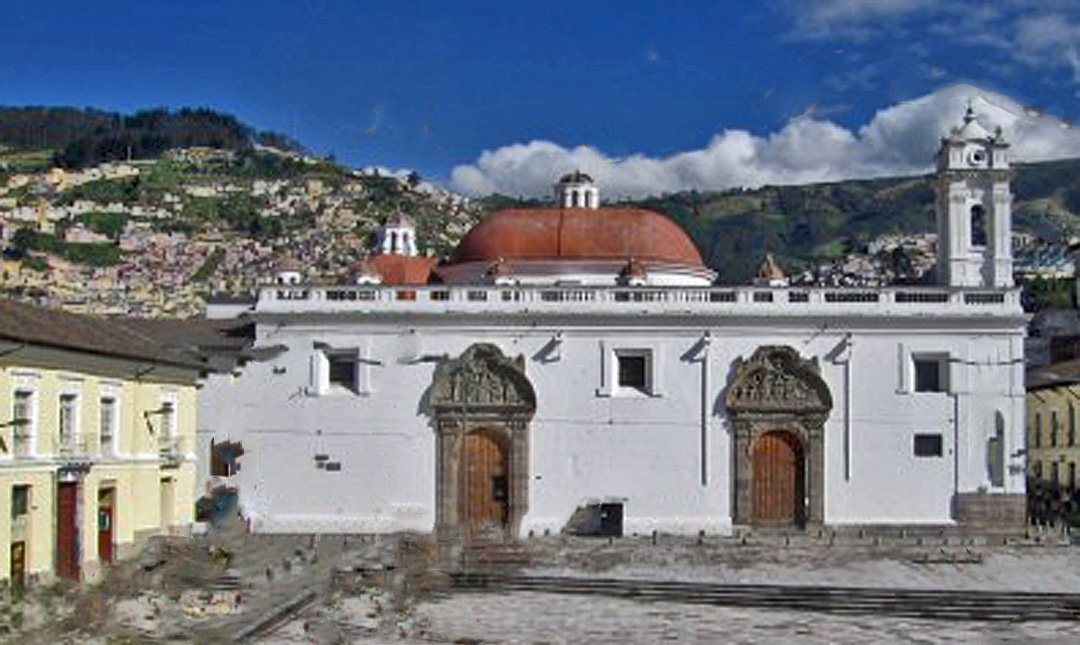
Iglesia de Santa Clara
The Convento de Santa Clara was founded in 1596 by Dona Francisca de la Cueva. The church and convent were constructed in the following years but was rebuilt in the Baroque style after the earthquake of 1645.
And then there is this attractive blue and white building that I found in my photo files.
It may be a church (Iglesia) but I cannot find the identification of it. If anyone knows please let me know!